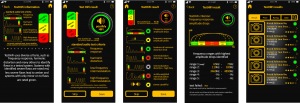
How to separate the wheat from the chaff when selecting audio systems?
Wouldn’t it be good to have a label on audio systems that informs us about the product quality ranking? Like on TV, a full HD or 4K sticker. This would not differentiate between high-end products, but allow for a classification of a HiFi entry level, a standard that mass-consumers could rely on.
Are ears the best tool for selecting an audio system?
Sure, some have an intensively educated and well-trained listening capability. Based on experience they hear differences in sound quality. However there are other elements which make it difficult to only rely on our ears. In the final stage of selecting, when only a few systems are left to choose from, our ears and our taste will drive our final decision. But how do you select these systems for your short list?
- Obviously, there is a sheer mass of available audio systems. We cannot listen to all of them and judge with our ears, which system might be the best for us. Therefore we relate to additional pre-selection criteria, before we can judge on the sound quality. We select by price, brand and others, and maybe deselect the wrong ones.
- Many buy their systems online, even without listening to them. This is often the case for smaller bluetooth speakers or alike, but not limited to those. In such cases, people rely mostly on design, brand and more or less subjective opinions, e.g. magazine or user ratings.
Bridging the gap between audiophiles and non-audiophiles.
There is no one standard or label for a good sound or HiFi in use. The audio industry has been discussing over decades how to create a sound quality standard. Vinyl, FLAC, High-Res., MQA and others have an impact on the sound quality but do not validate what we are listening to.
There are two groups in audio, those who don’t care and the audiophiles. Audiophiles always argue their system is high-end HiFi anyway while friends and others question the effort and investment value, although they also listen to music. We wanted to bridge the gap and make it easy for everybody to choose and listen to fair, trustful, good audio, i.e. HiFi.
So, we came up with TestHiFi to simply and objectively check an audio system and of course totally independent from any brand or advertising.
Imagine, there is a TestHiFi rating available for everybody. This could set a new HiFi label and become widely known and accepted like a “full HD” sticker on TVs. This would help to separate the wheat from the chaff and would make it easier for anybody to create a short list for audio systems prior to making a final purchase decision.
TestHiFi can also help with the equipment you have at home.
TestHiFi uses the iPhone connectivity options: Bluetooth, WLAN or cable, no matter how you connect the iPhone with the system. It sends a signal and records the signal with the built-in microphone. Just connect the iPhone with the system and you are all set for a test.
TestHiFi works with an average of three tests, each with a specific change in its position. For normal usage, the first position starts at 0.5m of the center of one speaker (left or right).
However, for the usage of an installed system in a room, with acoustical measures taken, we recommend to perform the TestHiFi test exactly as described, with the arm movement into three test positions, at your listening position rather than directly in front of one speaker. This will allow you to use TestHiFi also for checking your acoustic treatments.
What might be in it for an audiophile?
We like measures taken for room acoustics and very high-end audio systems. Also, we understand many audiophiles perform some room acoustic measurements.
Let us take an example of some mid-size speakers of high-end audio systems positioned on a stand and compare these with a high-end system’s pretty tall floor standing speaker. We would assume, measuring both systems show a difference in the range between 70-200Hz. Mid-size speakers often miss out on a bigger sized woofer and sometimes are supported by a subwoofer. Those might deliver quite a drop due to floor reflections, which might not be covered by any subwoofer.
TestHiFi would indicate such a drop with specific frequency range output.
TestHiFi with in-app purchases provides some very specific data as a result of the three position average measurement within seconds, and this performed just only with an iPhone.

However, although TestHiFi is a real and reliable measurement tool, it is designed to be used by non-audiophiles. It provides an easy test for interested beginners that would like to buy something not just small, flexible and modern design or brand, but a system with an acceptable HiFi quality.
TestHiFi aims to help the audiophile community growing!
Don’t you have the same impression? The audiophile community gets older and fails to involve younger generations although they also listen to music.
There is a lot of growth in the audio industry, predominantly around new speech controlled speakers, headphones, mobile phones and streaming. This growth comes with a tendency towards lower sound quality compared to the trend of vinyl discs revival and their related HiFi equipment. (Blog: Why people buy crappy sounding systems)
How many people value good quality sound? How much do people know about good quality sound, i.e. HiFi?
To grow the audiophile family, to invite younger generations to participate, to invite more diversity into the audiophile family, you need to offer something that can be easily understood by the new members.
TestHiFi is easy to understand also for a non-audiophile.